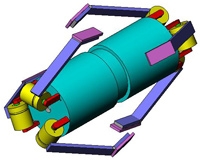
Putting the “Science” in “Science Fiction” – Aquaman
Aquaman is one of the members of DC Comics’ Justice League, although he does not gain nearly as much respect as his peers. Aquaman’s powers may not be as impressive as Superman’s or Green Lantern’s, but they would certainly be useful in the real world. In particular, the ability to breath underwater would open up many new and exciting possibilities.
Breathing underwater seems like it would be a very easy thing to do, since every sea creature besides aquatic mammals has the ability to do so. However, it is proving to be a difficult ability to replicate. Scientists and inventors have been struggling with the problem of allowing men and women to breathe underwater since the 1400’s, but modern diving technology really began in 1837, with the creation of the “standard diving dress.” The first models consisted of a watertight suit made of rubber that was sandwiched between two layers of tough fabric. A metal and glass helmet sealed around the neck and kept the water out, while air was provided by a hose that led to a pump on the surface. Although this system was revolutionary for the time it had many limitations, and was replaced by the Scuba system, which first became commercially available in 1943 with Jacque Cousteau’s Aqualung.

Scuba is an acronym, S.C.U.B.A., which stands for Self-Contained Underwater Breathing Apparatus. A Scuba system contains a face mask and breathing unit connected to a pressurized air tank the diver carries with them. This unit is far more portable than the previous diving suits, but provides a limited amount of dive time since a tank can only carry so much oxygen at a time. In order to solve this problem some divers use rebreathers, a different system that recycles the air the diver breathes out and removes carbon dioxide from it while adding more oxygen. This system increases dive time, but there are several potential problems with it and it has not been adopted by all divers.
Although these diving systems allow human beings to operate underwater for long periods of time, they all rely on bringing air from the surface, and so do not allow a diver to operate indefinitely. In an effort to improve on dive length, several different technologies are under development to allow divers to extract oxygen from the water directly. One such artificial gill technology is called LikeaFish, and is under development by Alan Bodner and his team. This system draws water into a cylindrical housing and uses a high-speed centrifuge to create a pocket of low water pressure in the centre. This low pressure pocket pulls dissolved air from the water, and then transfers it to a storage tank to allow the diver to breathe it. As long as the centrifuge is able to spin, the system will extract air, allowing the operator to breathe underwater as long as the machine has power. The main concern with such a system is how long a battery would last. Working prototypes have been developed and Brodner`s team is currently working to make the device smaller and more energy efficient in order to minimize weight and maximize battery life.
A second system is under development by Glen McHale and his colleagues at Nottingham Trent University. They got the idea for their system from watching diving beetles and other insects who could survive underwater. This idea uses material that repels water to create a membrane of air between the water and the material itself. This membrane allows oxygen to pass into it and carbon dioxide to pass out of it, allowing air to be extracted from water and waste gases to be removed. This technology looks very promising but it has a problem with bulk. In order to extract the amount of oxygen that a human being would need requires a very large surface area of membrane. Although there are techniques to make the system more compact in its current form it would still be very bulky, and so more research must be done before the technology is truly feasible to use. Other scientists are working on a similar system, but are looking at using nanoscale sieves that would allow oxygen to pass through a membrane into an air bottle, while water and other gasses would not be able to enter. These two technologies work in an almost identical manner, and so would have similar problems as well as similar advantages.

A third possibility for extracting oxygen from water is “cracking” the water through the use of electrolysis. In electrolysis an electrical current is passed through water, causing it to split into oxygen and hydrogen. Although this system would require a very large deal of energy it would be very useful if hydrogen fuel cell technology continues to be pursued, as hydrogen fuel would be a by-product of the reaction.
All of these technologies seem promising, but there are a few inherent problems with artificial gills that will need to be addressed before they become feasible for everyday use. The first is moving enough water through the gill, as the amount of oxygen extracted is directly linked to how much water passes through the mechanism and human beings require a great deal of oxygen to function. This need for oxygen is increased when performing an aerobic activity like swimming quickly. In addition, after a certain depth pressure makes breathing pure oxygen toxic, and so a system of diluting the oxygen flow with other gasses would be required. Another problem is supplying power to the gill, as modern batteries would have a hard time keeping up with the energy requirements of some types of artificial gill for extended periods of time.
Another serious problem that needs to be addressed is the possibility of areas of water that are anoxic (have very low amounts of oxygen) or have high concentrations of dissolved carbon dioxide or methane gas. An anoxic environment could lead to rapid suffocation, while other gases could make their way into the gill and poison the operator before they realized what was happening.

The creation of artificial gills will be very useful to people in many different ways. These devices will not only allow divers to stay underwater for much longer periods of time, but will also allow submarines, aquatic habitats, and other places people live and work underwater to extract the air they need from the water around them. This will negate the need to rely on getting air from the surface and help reduce the risk of submarines running out of air if they sink. Other possible uses for artificial gills include short-term emergency measures for submariners and people who work in underwater habitats, allowing them to escape to the surface in case of disaster, and improving the efficiency of engines that must work underwater by providing them with more oxygen. It will take some time for artificial gill technology to be perfected, but once these devices become feasible they will open up the wonders of the underwater world never seen before.













